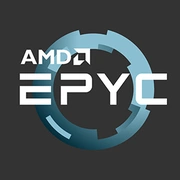AMD EPYC 4484PX

The AMD EPYC 4484PX processor is a powerhouse for server applications. With a 5nm technology, it offers incredible performance with a total of 12 cores and 24 threads, making it suitable for multitasking and heavy workloads. The base frequency of 4.4 GHz and a max turbo frequency of 5.6 GHz ensure that it can handle demanding tasks with ease.
One of the standout features of this processor is its massive 128 MB L3 cache, which allows for faster data access and processing. The integrated Radeon Graphics model is also a nice addition, providing decent graphical capabilities for server applications.
With a TDP of 120W, the EPYC 4484PX strikes a good balance between power efficiency and performance. This makes it an attractive option for data centers and other server environments where power consumption is a key concern.
Overall, the AMD EPYC 4484PX processor is a top-tier option for server applications, offering exceptional performance, efficient power consumption, and impressive features that make it a strong contender in the server CPU market.
Basic
Label Name
AMD
Platform
Server
Launch Date
May 2024
Model Name
?
The Intel processor number is just one of several factors - along with processor brand, system configurations, and system-level benchmarks - to be considered when choosing the right processor for your computing needs.
EPYC 4484PX
Code Name
Raphael
Foundry
TSMC
Generation
EPYC (Zen 4 (Raphael))
CPU Specifications
Total Cores
?
Cores is a hardware term that describes the number of independent central processing units in a single computing component (die or chip).
12
Total Threads
?
Where applicable, Intel® Hyper-Threading Technology is only available on Performance-cores.
24
Performance-core Base Frequency
4.4 GHz
Performance-core Max Turbo Frequency
?
Maximum P-core turbo frequency derived from Intel® Turbo Boost Technology.
5.6 GHz
L1 Cache
64 KB per core
L2 Cache
1 MB per core
L3 Cache
128 MB shared
Bus Frequency
100 MHz
Multiplier
44.0
Unlocked Multiplier
No
CPU Socket
?
The socket is the component that provides the mechanical and electrical connections between the processor and motherboard.
AMD Socket AM5
Technology
?
Lithography refers to the semiconductor technology used to manufacture an integrated circuit, and is reported in nanometer (nm), indicative of the size of features built on the semiconductor.
5 nm
TDP
120 W
Max. Operating Temperature
?
Junction Temperature is the maximum temperature allowed at the processor die.
47 °C
PCIe Version
?
PCI Express is a high-speed serial computer expansion bus standard used for connecting high-speed components, replacing older standards such as AGP, PCI, and PCI-X. It has gone through multiple revisions and improvements since its initial release. PCIe 1.0 was first introduced in 2002, and in order to meet the growing demand for higher bandwidth, subsequent versions have been released over time.
5
Transistor Count
17.84 billions
Memory Specifications
Memory Type
?
Intel® processors come in four different types: Single Channel, Dual Channel, Triple Channel, and Flex Mode. Maximum supported memory speed may be lower when populating multiple DIMMs per channel on products that support multiple memory channels.
DDR5-5200
Memory Channels
?
The number of memory channels refers to the bandwidth operation for real world application.
2
ECC Memory Support
Yes
GPU Specifications
Integrated Graphics Model
?
An integrated GPU refers to the graphics core that is integrated into the CPU processor. Leveraging the processor's powerful computational capabilities and intelligent power efficiency management, it delivers outstanding graphics performance and a smooth application experience at a lower power consumption.
Radeon Graphics
Miscellaneous
PCIe Lanes
28
Benchmarks
Passmark CPU
Single Core
Score
4251
Passmark CPU
Multi Core
Score
51115
Compared to Other CPU
Passmark CPU Single Core
Passmark CPU Multi Core
Share in social media
Or Link To Us
<a href="https://cputronic.com/cpu/amd-epyc-4484px" target="_blank">AMD EPYC 4484PX</a>